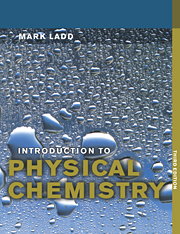Book contents
- Frontmatter
- Contents
- Preface
- Physical constants and other numerical data
- Prefixes to Units
- 1 Structure, energy, mechanism
- 2 Atoms, molecules and their structures
- 3 Determination of structure
- 4 Energy and energetics
- 5 States of matter: gases and liquids
- 6 States of matter: solids
- 7 Phase rule and properties of solutions
- 8 Chemical equilibrium
- 9 Electrochemistry
- 10 Chemical kinetics and mechanisms of chemical reactions
- Appendix 1 Problem-solving with personal computers
- Appendix 2 Stereoviewing
- Appendix 3 Average classical thermal energies
- Appendix 4 Reduced mass
- Appendix 5 Spherical polar coordinates
- Appendix 6 Gamma function
- Appendix 7 Slater's rules
- Appendix 8 Linear least squares and the propagation of errors
- Appendix 9 Determinants and cofactors
- Appendix 10 Solution of a second-order differential equation
- Appendix 11 Separation of variables
- Appendix 12 Overlap integrals
- Appendix 13 Partial derivatives
- Appendix 14 Numerical integration
- Appendix 15 Fermi-Dirac statistics
- Appendix 16 Calculation of Madelung constants
- Appendix 17 The hypsometric formula: an example of the Boltzmann distribution
- Appendix 18 Tables of physical data
- Bibliography
- Answers to numerical problems
- Index
5 - States of matter: gases and liquids
Published online by Cambridge University Press: 05 June 2012
- Frontmatter
- Contents
- Preface
- Physical constants and other numerical data
- Prefixes to Units
- 1 Structure, energy, mechanism
- 2 Atoms, molecules and their structures
- 3 Determination of structure
- 4 Energy and energetics
- 5 States of matter: gases and liquids
- 6 States of matter: solids
- 7 Phase rule and properties of solutions
- 8 Chemical equilibrium
- 9 Electrochemistry
- 10 Chemical kinetics and mechanisms of chemical reactions
- Appendix 1 Problem-solving with personal computers
- Appendix 2 Stereoviewing
- Appendix 3 Average classical thermal energies
- Appendix 4 Reduced mass
- Appendix 5 Spherical polar coordinates
- Appendix 6 Gamma function
- Appendix 7 Slater's rules
- Appendix 8 Linear least squares and the propagation of errors
- Appendix 9 Determinants and cofactors
- Appendix 10 Solution of a second-order differential equation
- Appendix 11 Separation of variables
- Appendix 12 Overlap integrals
- Appendix 13 Partial derivatives
- Appendix 14 Numerical integration
- Appendix 15 Fermi-Dirac statistics
- Appendix 16 Calculation of Madelung constants
- Appendix 17 The hypsometric formula: an example of the Boltzmann distribution
- Appendix 18 Tables of physical data
- Bibliography
- Answers to numerical problems
- Index
Summary
Introduction
Matter exists in three states, gaseous, liquid and solid. It is convenient to discuss the properties of matter under these main headings, although certains types of substances, such as vitreous materials and liquid crystals, do not fall clearly into one or other of them.
The gaseous state is the most straightforward to study. The simplicity arises from the fact that the molecules of a gas are, normally, independent of one another, with negligible forces of interaction. Consequently, many of their properties are independent of their chemical nature and may be described by general gas laws; we have made use of this fact in the previous chapter and here we describe these laws in more detail.
Gases are characterized by large volume changes with change of temperature or pressure and by their ability to flow into and fill the space available to them; they are miscible with one another in all proportions. A liquid, like a gas, has no form, but it has a definite volume and takes up the shape of its containing vessel. It has a boundary surface that restricts its extent and which is responsible for many of its properties. The cohesive forces between molecules in a liquid are stronger than those between molecules in a gas, but weaker than those characteristic of solids. Under normal conditions, gases behave as an assemblage of freely moving molecules or atoms, whereas solids form rigid structures.
- Type
- Chapter
- Information
- Introduction to Physical Chemistry , pp. 199 - 238Publisher: Cambridge University PressPrint publication year: 1998



